|
|
|
Published
on 12
Feb 2011
|
All rights reserved.
|
|
|
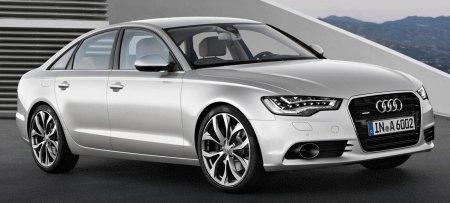
The
progress of Audi A6 (as well as Audi itself) in the past decade and a
half was really amazing. I remember how difficult its predecessor, Audi
100, lived under the shadow of Mercedes E-class and BMW 5-series.
Things started changing since 1997 when the first all-new A6 was
launched. Its elegant styling and high build quality lured customers
from its counterparts and established a strong reputation for Audi. The
next generation from 2004 not only raised this standard further, but
also brought stronger performance and handling. Today, the
Audi is no longer seen as an inferior alternative to its German rivals,
but a stronger statement of your taste and pursuit of quality. In terms
of global sales, it even outsells its arch-rivals and tops the class,
thanks partly to its strong penetration into China.
That said, what the previous A6 still failed to do was to match its
rivals, especially BMW 5-series, for dynamic finesse. Its handling was
still hampered by its inherent nose-heavy construction (blame that
Quattro and longitudinal engine), which also compromised its steering
and ride quality. We would like to see if Audi can sort out these
problems in the new generation A6 and satisfy keen drivers finally.
Only in this way, it could win the hearts of our readers.
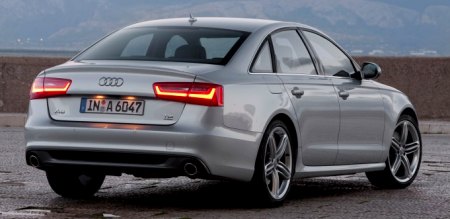
Before coming to its driving, let's get a briefing on the car first.
Unquestionably, the new A6 has many aspects improved over its
predecessor, but that
does not include one thing – styling. Compare with the last two
generations the new car is conservatively styled. While it still sports
many elegant details, the overall proportion and features are rather
conservative, a sharp contrast to our recent favourite designs, Jaguar
XF and XJ. The once forward-thinking design theme of Audi has been
sacrificed for the need to please wider audience, including
conservatives like Chinese. That is really sad. It seems that Audi has
exchanged its traditional approach with Mercedes-Benz, which is going
radical these days. Who is right ? we shall see soon…
As we have mentioned before, the new A6 is a close sister of A7. Both
cars share not only the MLP platform (as does A8) but also the same
size, much of the chassis construction and interior. A close look to
its cabin will find the same dashboard, center console and steering
wheel, if not the same door panels. Such sharing enables it to employ
classy materials without pushing the cost too much.
The new body is slightly wider and lower than the outgoing car, but its
overall length remains unchanged. Because the MLP platform has the
front axle moved before the clutch, it enables a longer wheelbase (2912
mm instead of 2843 mm), hence slightly better weight distribution and
more interior space. Aerodynamics is very good. Drag coefficient is
only 0.26, thanks to the use of smooth underfloor panels and spoilers.
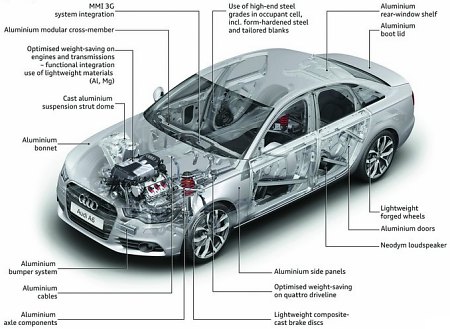
As in A7, the chassis is made of largely steel but also some aluminum
components to cut weight. Audi did not opt for its ASF aluminum
spaceframe technology because that would be too costly for the class,
unlike the more expensive A8. Just as BMW 5-series found out, by
selective use of aluminum components there is still room for weight
saving. In the new A6, aluminum comprises of 20 percent of the
body-in-white by weight. These include the pressed aluminum bonnet,
front fenders, doors and boot lid, the cast aluminum suspension strut
domes and suspension components, as well as extruded aluminum front
bumper beam and cross member behind the dashboard. Its use of aluminum
is even more extensive than BMW 5-series, no wonder the A6 has its
weight so well controlled. For instance, an A6 3.0TDI Quattro weighs
exactly the same as BMW 530d, even though it is loaded with the
additional 4WD hardware.
The suspension system has little surprise: 5-link front suspensions and
trapezoidal 4-link rear suspensions are the tradition of Audi. Their
anti-dive geometry suits the nose-heavy car, so there is no reason to
abandon them. Also like the previous car, all control arms are casted
in aluminum to keep unsprung weight low. What's new are electronic
adaptive damping and air suspensions with 3 ride height settings. They
are listed as cost options so that not to blunt sales of the
bread-and-butter models.
Motoring journalists, however, are offered with the fully optioned cars
for test drive, so they would tend to give more favorable comments.
These cars also include the optional Sport Differential (an active rear
differential instead of the standard car's brake-actuating torque
vectoring), active steering and Audi Select Drive. The latter is a
control system which provides 3 modes (auto, comfort and dynamic) to
alter suspension, transmission, steering, throttle, ESP etc.
Furthermore, there is another mode for the driver to customize
individual settings to his taste. Quattro models employ the latest
crown-gear Torsen center differential to split torque 40:60 front to
rear. In short, everything is just the same as in A7.

The same can be said to powertrains. With the exception of 2.0 TDI
(177hp), all engines are shared with its sister car A7.
These include 2.8 FSI Valvelift V6 (204hp), 3.0 TDI V6 (204hp or 245hp)
and 3.0 TFSI supercharged V6 (299hp). They offer competitive
performance and outstanding fuel economy and emission, thanks to the
use of direct injection, auto stop-start and brake energy regeneration.
The
choices for transmission include 6-speed manual, Multitronic CVT and
7-speed S-Tronic
twin-clutch. The latter is mandatory on the range-topping 3.0 TFSI and
245hp 3.0 TDI. By the way, Quattro is also standard on the duo.
Having gone through the
technical
aspect, we shall return to our question: is the new A6 as good to drive
as its key
rivals,
namely BMW 5-series, Mercedes E and Jaguar XF ?
In some aspect yes, and
in
others no.
In terms of performance and powertrain, the A6 is quite competitive.
Most of
its
engines are refined, torquey and flexible, especially the excellent
supercharged petrol V6 – just as you would expect from previous
reading. The
245hp 3.0 TDI is good, too. Save a little roughness at startup, it is
perfectly
refined. Our only disappointment concerns the 170hp 2.0 TDI engine,
which is no
where as strong as the 204hp Mercedes 250CDI twin-turbo engine. And you
know,
these are the best selling engines in the class. Less problematic is
the lack
of a really powerful twin-turbo diesel V6 to rival BMW 535d and Jaguar
XF 3.0D
275hp, because from sales figures we know such engines are never big
sellers. What
it might affect is more psychological, i.e. leaving a superior
performance
image to its rivals. And what about the lack of a V8 engine ? Don't
worry, on
the pipeline there is an S6 with twin-turbo 4.0-liter V8.
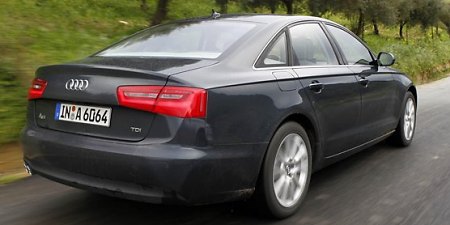
Audi's 7-speed S-Tronic transmission is a good twin-clutch automated
manual gearbox. However, for ultimate smoothness it is still no match
with the torque-converter automatic transmissions on its rivals,
especially the ZF 8-speed unit on BMW and ZF 6-speeder on Jaguar.
Twin-clutch box might be fine on the A5 / S5,
but it feels a little out of place in a luxury executive car.
On motorway, the A6 displays impressive refinement. Its cabin is
superbly insulated from wind, engine and road noise. The ride is
compliant, even on standard suspensions with steel springs, though body
control is predictably not as good as its rear-drive rivals due to the
nose-mounted engine. Choose the S-Line version, which comes with
stiffer suspensions and low-profile 245/45ZR18 tires, you will find
much better body control, accompany with impressive grip and endless
Quattro traction. Opt for the active differential and you will be
amazed how precise its nose points. In this configuration, the A6 is
almost a driver's car.
Nevertheless, those enjoy pushing their cars to the limit may find the
A6 not satisfying enough. The artificial-feeling electric power
steering is one reason. It makes the car difficult to engage the
driver, no matter how hard it corners. Another reason is the lack of
agility. This is especially obvious on the 3.0 TDI, whose weighty
diesel V6 makes the car less agile than the better balanced BMW 530d
and Jaguar XF 3.0D. It goes without saying that the front-drive 2.0 TDI
is even less satisfying to keen drivers.
The optimal choice is of course the 3.0 TFSI Quattro S-Line with Sport
Differential, but it has its faults, too – a very firm ride that suits
German highway more than anywhere else. This makes it a nightmare to
those regularly ride on B-roads or concrete pavement. You might think
air suspensions could be an answer. Yes, it does help to certain
extent, but it also softens the steering response, thus it is not a
good idea to keen drivers. No matter in what configurations, the A6
fails to deliver a ride and handling combo as good as its rear-drive
rivals. Once again, this is attributed to its non-ideal drivetrain
layout.

One area the Audi does beat its rivals is the interior. Although from
design point of view it is not as inspiring as Jaguar's, it is still
comfortably more tasteful than those of 5-series and E-class. In terms
of materials and build quality, the Audi has lifted the bar again.
Everything looks rich and impeccably assembled, clearly a class above
its rivals. In fact, it feels nearly as classy as the A8 ! Besides,
provided you can afford, you can have tons of gadgets, such as MMI
multimedia control, DVD TV entertainment system, head-up display,
Google Earth navigation, B&O HiFi, multi-zone climate control and
electric door closing. Safety features include Pre-sense active safety
system, active lane keeping assist, automatic parking, Night Vision
thermal camera… all sorts of things you can found on the A8. The cabin
of A6 is spacious and airy. The boot is generous, too.
For sure, the build quality will
continue to
be a strong selling point of the car. That said, to those putting
driving dynamics on top priority, the A6 still trails BMW 5-series and
Jaguar XF. To those pursuing ultimate comfort, Mercedes E-class still
seems to be a better bet. However, taking all things into account, the
Audi is unquestionably a strong contender in the class and the one you
have to consider. |
Verdict:     |
| Published
on 28
Apr 2012 |
All rights reserved.
|
|
| Audi S6
|
|
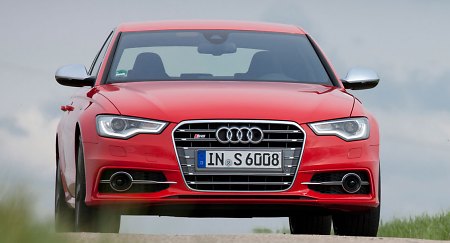
In the past decade,
the
power war among German premium car makers became so intense that they
built some of the most dramatic powertrains ever appeared on production
cars. BMW introduced a high-revving V10 on its E60 M5; Mercedes-AMG
resurrected its "6.3" nameplate on its performance E-class; Audi was
even madder, producing a pair of sports saloons with a
Lamborghini-derived V10, i.e. the naturally aspirated S6 and the
biturbo RS6. These cars pushed the power war to the peak.
Very much like the "muscle car" era running in the 1960s, that kind of
pursuit of gigantic power is not sustainable. Following the effective
of stricter CO2 legislations, the German
have to rationalize their
offerings and seek more sensible solutions. Any engines with more than
8 cylinders have to be axed – the new M5 was the first to switch to
twin-turbo V8, and now Audi is doing the same thing to its S6. Bye-bye
to the characterful 5.2-liter V10, welcome a new 4-liter twin-turbo V8.
Finance guys at Volkswagen group will be delighted to hear that the new
engine is going to have a much higher production volume. It will serve
not only the S6 and RS6 but also S8 and Bentley Continental GT – both
of which we have reviewed recently – and hopefully more cars in the
future. It makes sense to the environment. It makes even more sense to
VAG's balance sheet.
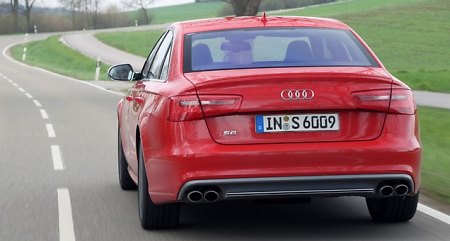
So how is the new engine? As we already know, it features "reversed
breathing", cross-bank turbocharging and a pair of twin-scroll turbos
to achieve a lag-free power delivery. Its direct injection, auto
stop-start, brake energy regeneration and cylinder deactivation (which
shuts down 4 cylinders under light load) contribute to a fuel saving of
25 percent over the outgoing V10. So you guess it must be a fabulous
engine? Not necessarily. While we gave positive comments to the engines
on Audi S8 and Bentley Continental GT
V8, this particular version is more disappointing. It behaves too
civilized. Its noise is so subdued that it doesn't sound like a
performance engine. Its maximum output is deliberately detuned to 420
hp in order to leave space for the forthcoming RS6. This mean it is a
full 100 horsepower down from the S8 ! As a result, its top end
delivery is flat, failing to thrill you like its sister engines. This
is all the more bitter as you know what it could have been capable of.
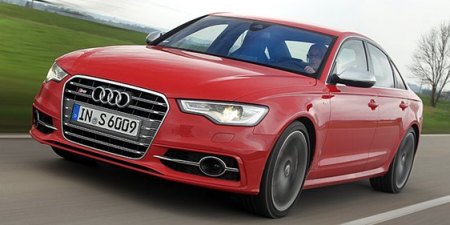
The rest of the package has a similar
problem. Although it is equipped with all the high-tech mechanicals you
can dream of, say, 40:60 Quattro system, torque vectoring active rear
differential, Audi drive select control system, 7-speed S-Tronic DCT,
adaptive air suspensions, a 10 mm lower ride height, fat rubbers and
optional ceramic brakes, the S6's handling never feels really sharp and
agile. Handicapped by its 1.9-ton weight and a relatively soft
suspension setting, it feels bulky to steer and a bit clumsy on
difficult roads. Its
steering lacks real feedback from the tarmac no matter in which
setting. Its gearbox does not respond to your requests as quickly as
you would expect. As a whole, the S6 feels hopelessly soft and cultured
beside an M5, AMG or Panamera. On the positive side, you can still find
the traditional merits of Audi – excellent traction and grip, good
high-speed stability and cruising refinement.
Make no mistake, the S6 does not intend to be the ultimate sports
saloon. That task will be taken by RS6, whose sportier setup and highly
tuned engine might result in a different story. Unfortunately, this
leaves the S6 in an embarrassing position – it is neither as
comfortable as the regular A6 or BMW 550i, nor as thrilling to drive as
M5 or E63
AMG. |
Verdict:    |
| Published
on 15
Apr
2013 |
All rights reserved.
|
|
| Audi RS6
Avant |
|
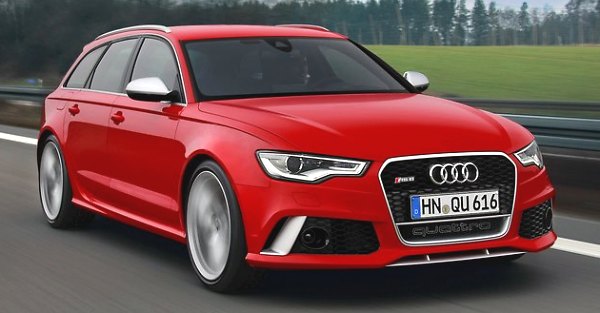
|
11 years ago, the first
generation RS6 introduced a twin-turbo 4.2-liter V8 to produce a
class-leading 450 horsepower. Mercedes and BMW immediately responded
with the 476 hp E55 AMG and 507 hp M5. Since then German performance
saloons entered a war of power. To overwhelm its rivals, the next
generation RS6 borrowed the 5-liter V10 from Lamborghini Gallardo and
turbocharged it to pump out 580 horsepower, guaranteeing to be
unbeatable during its whole life. The war is slightly dampened in the
recent couple of years as the German have been adjusting their
strategies to meet the stringent demand for CO2
reduction. BMW and Mercedes turned to downsized turbocharged V8s. Audi
followed suit with a new 4.0-liter twin-turbo V8 for its S6, S7 and S8.
Now a higher tuned version of the same motor powers the new RS6.
Downsizing from 5-liter V10 to 4-liter V8 is a sensible step to improve
the RS6. One should remember that the outgoing car, despite of its
superior numbers, was hampered by a nose-heavy handling and a hefty
price tag thus was never a commercial success. Now switching to the
smaller V8 allows it to lighten its nose, while the larger economy of
scale should cut cost. The question is, can it deliver the same power?
The answer is no, but not far away. The new motor produces 560 hp, 20
down on its predecessor and 25 less than the current class leader,
Mercedes E63 AMG S. However, its maximum torque of 516 lbft is 37 lbft
stronger than before, although its torque band (1750-5500 rpm) is
slightly narrower than the old car (1500-6250 rpm) as well as BMW M5
(1500-5750 rpm). From these figures you can see its turbos kick off at
slightly higher rev, because it needs larger turbos to produce some 1.2
bar of boost pressure (a far cry from the V10's 0.7 bar). Fortunately,
the inverse-breathing architecture of this V8 enables it to employ
twin-scroll turbos thus greatly reduces turbo lag. Moreover, the V8 is
also able to cut fuel consumption by a massive 40 percent, thanks
partly to the implementation of cylinder on demand (COD) technology,
which utilizes the "Valvelift" mechanism to shut down 4 cylinders under
light load.
 |
In the real world, you would find the new engine just as smooth,
powerful and elastic as the V10. There might be a touch more turbo lag,
but it is still a very responsive powerplant by turbocharging standard.
Likewise, the exhaust note might be not quite as exciting as the V10's,
but it is still worth praising. Paired with the ZF 8-speed automatic
gearbox, the RS6 provides a relentless performance. Partly thanks to
its weight reduction of 90 kg, partly thanks to the availability of
launch control, it is capable to cut 0-60 mph from 4.4 to an
astonishing 3.8 seconds – well, not quite in the league of E63 AMG S
4matic, but it beats an M5 by a decisive 0.4 second! As for top speed,
you may opt for dynamic package to raise its speed regulation to 190
mph. What a performance saloon… no, it is in fact an estate!
The RS6 abandons the S6's 7-speed dual-clutch gearbox because the
latter is not strong enough to withstand its tremendous torque. If not,
I suppose the DCT should be a better option. As good as the ZF 8-speed
automatic is, it is still not as responsive as a proper DCT owing to
the time taken for its torque converter to engage. This mean BMW M5 has
a slight advantage in the eyes of keen drivers. However, for a luxury
performance saloon/estate like this, automatic might be more appealing
to most customers, as AMG found out long ago.
More controversial is the lack of saloon body. Following the smaller
RS4, the RS6 is available only in the form of Avant because in the past
few Audi drivers opted for the saloon versions of RS models. The Avant
body might benefit weight distribution a bit, but I suppose the image
it gives us is more multi-purpose than purposeful. Even though there
are sufficient styling tweaks made to differ it from lesser A6 or S6
Avant, it still doesn't look as convincing as a saloon can be.
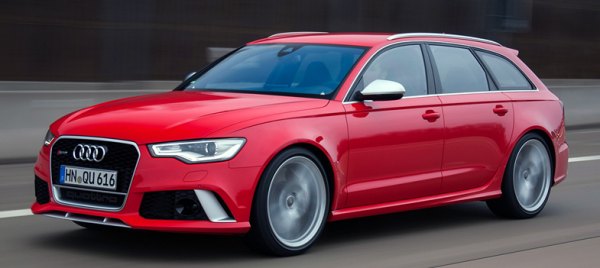 |
The RS6's standard air suspension is set 20 mm lower than that of the
S6. If that is not sporty enough, you may opt for the DRC (Dynamic Ride
Control) suspension, which is so familiar to the drivers of RS4 and
RS5. It uses steel springs and adaptive dampers instead of air struts.
The dampers are linked hydraulically between diagonal wheels to control
pitch and roll in hard cornering. Other goodies are also shared with
RS4 and RS5, such as the 40:60 Quattro system, Audi Drive Select
system, computer-controlled variable-ratio steering, torque-vectoring
braking and a pair of performance options – ceramic brakes and active
rear differential. If you equip all these things, you would find the
RS6 edges closer to the top of the class again. The combined effect of
active differential and lighter engine means the new car no longer
understeers heavily. You are still aware that the engine is hanging
beyond the front axle, but the sense is much reduced now because the
car dips little when braking into corner and it turns in more eagerly.
Understeer is no longer its basic instinct. It still doesn't power
slide like a rear-driver, but frankly for a car so large and powerful
oversteer is no longer realistic to play on public roads. On the
contrary, most drivers will appreciate its immense traction and grip,
and the general feeling that its fine handling is indestructible by any
roads, any surfaces.
Unfortunately, the Achilles' heel of Audi is again steering feel, or
the lack of it. The dynamic mode of Audi Drive Select might increase
speed and weight, but it does nothing to improve the video-game
feedback. As a result, the driver feels isolated from the road. Many
electrical racks have similar problems, but none of its rivals suffer
as much, probably because of its permanent 4WD system. As a result, the
RS6 still fails to match the more involving E63 AMG S 4matic, M5 and
XFR in the performance executive car class.
|
Verdict:     |
|
|
|
|
|
|
|
|
|
|
A6 2.8 FSI
|
2011
|
| Front-engined,
FWD |
| Steel monocoque |
Steel + aluminum
|
4915 / 1874 / 1455 mm
|
| 2912 mm |
V6, 90-degree
|
| 2773 cc |
DOHC 24 valves, VVT, VVL
|
| VIM |
| DI |
| 204 hp |
| 206 lbft |
CVT with 8-spd manual mode
|
F: 5-link
R: multi-link
|
| - |
| 225/55R17 |
1610 kg
|
| 149 mph (c) |
7.3 (c)
|
| - |
|
A6 3.0TDI Quattro
|
2011
|
| Front-engined,
4WD |
| Steel monocoque |
Steel + aluminum
|
4915 / 1874 / 1455 mm
|
| 2912 mm |
V6, 90-degree, diesel
|
| 2967 cc |
DOHC 24 valves
|
VTG turbo
|
| CDI |
| 245 hp |
| 369 lbft |
7-speed twin-clutch
|
F: 5-link
R: multi-link
|
-
|
| 225/55R17 |
1720 kg
|
| 155 mph (limited) |
5.8 (c)
|
| - |
|
A6 3.0TFSI Quattro
|
2011
|
| Front-engined,
4WD |
| Steel monocoque |
Steel + aluminum
|
4915 / 1874 / 1455 mm
|
| 2912 mm |
V6, 90-degree
|
| 2995 cc |
DOHC 24 valves, VVT
|
Supercharger
|
| DI |
| 299 hp |
| 324 lbft |
7-speed twin-clutch
|
F: 5-link
R: multi-link
|
Adaptive air spring + damping
|
| 245/45ZR18 |
1740 kg
|
| 155 mph (limited) |
5.2 (c)
|
| - |
|
|
|
|
|
Performance
tested by: -
|
|
|
|
|
|
|
A6 3.0TFSI Quattro (US)
|
2011
|
| Front-engined,
4WD |
| Steel monocoque |
Steel + aluminum
|
4915 / 1874 / 1455 mm
|
| 2912 mm |
V6, 90-degree
|
| 2995 cc |
DOHC 24 valves, VVT
|
Supercharger
|
| DI |
310 hp
|
| 325 lbft |
8-speed automatic
|
F: 5-link
R: multi-link
|
-
|
| 245/40ZR19 |
1835 kg
|
| 130 mph (limited) |
5.3 (c) / 5.4* / 5.6*
|
13.4* / 13.7*
|
|
S6
|
2012
(2014)
|
| Front-engined,
4WD |
| Steel monocoque |
Steel + aluminum
|
4931 / 1874 / 1440 mm
|
| 2916 mm |
V8, 90-degree
|
| 3993 cc |
DOHC 32 valves, DVVT
|
Twin-turbo
|
DI, cylinder deactivation
|
420 hp / 5500-6400 rpm
(450 hp / 5800-6400 rpm)
|
406 lbft / 1450-5250 rpm
|
7-speed twin-clutch
|
F: 5-link
R: multi-link
|
Adaptive air spring + damping
|
| 255/40ZR19 |
1895 kg
|
| 155 mph (limited) |
4.6 (c) / 3.7*
(4.2 (c) / 3.9* / 3.8***)
|
9.2* (9.8* / 9.9***)
|
|
RS6 Avant
|
2013
|
| Front-engined,
4WD |
| Steel monocoque |
Steel + aluminum
|
4979 / 1936 / 1461 mm
|
| 2915 mm |
V8, 90-degree
|
| 3993 cc |
DOHC 32 valves, DVVT
|
Twin-turbo
|
DI, cylinder deactivation
|
560 hp / 5700-6700 rpm
|
516 lbft / 1750-5500 rpm
|
8-speed automatic
|
F: 5-link
R: multi-link
|
Adaptive damping
|
| 275/35ZR20 |
1935 kg
|
| 190 mph (limited) |
3.8 (c) / 3.7**
|
| 8.7** |
|
|
|
|
|
Performance
tested by: *C&D, **Autocar, ***MT
|
|
|
|
|
|
|
RS6 Avant Performance
|
2016
|
| Front-engined,
4WD |
| Steel monocoque |
Steel + aluminum
|
4979 / 1936 / 1461 mm
|
| 2915 mm |
V8, 90-degree
|
| 3993 cc |
DOHC 32 valves, DVVT
|
Twin-turbo
|
DI, cylinder deactivation
|
605 hp / 6100-6800 rpm
|
553 lbft / 2500-5500 rpm
|
8-speed automatic
|
F: 5-link
R: multi-link
|
Adaptive damping
|
| 285/30ZR21 |
1950 kg
|
| 190 mph (limited) |
3.6 (c)
|
| - |
|
|
|
|
|
|
|
Performance
tested by: -
|
|
|
|
|
|
|
|
|
Copyright©
1997-2016
by Mark Wan @ AutoZine
|
|